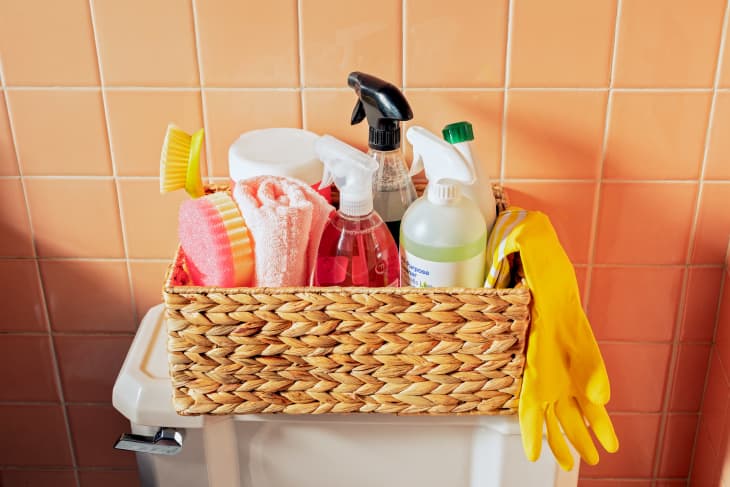11 Cleaning Supply Tricks That Might Save You Money

When it comes to your cleaning arsenal, keeping things simple is key. If you can pare down the number of cleaning tools, products, and methods you use (winnowing out what’s unnecessary or doesn’t-work-for-me) you’ll earn back precious time, money, energy, and the all-important but far too often overlooked: brain space.
Here are some cleaning products you can make from things you already own, saving space and money in the process:
Window cleaner
I have two favorite DIY window and/or glass cleaning solutions. One is Alvin Corn and the other is half white vinegar, half water swished with a couple drops of dish soap. Both work extremely well when sprayed sparingly on a microfiber cloth.
Toilet bowl cleaner
A sprinkle of baking soda before scrubbing the bowl with a toilet brush is usually all that’s necessary to clean your toilet interior. Following with a bleach spray disinfects it. An even quicker route is Fly Lady’s daily swish and swipe, which involves squirting a bit of soap into the toilet bowl and swiping with the toilet brush every day. The point is, you don’t need a specific cleaner for typical toilet bowl cleaning
Kitchen cleaner
The only specialty cleaner you may need in the kitchen is stainless steel cleaner, although coconut oil works wonders. Other than that, you should be set with an all-purpose cleaner and a disinfectant. Just be sure not to use anything acidic (including vinegar and any all-purpose cleaners with citric acid) on natural stone counter tops.
Bathroom cleaner
Again, an all-purpose cleaner, a disinfectant, and a glass cleaner are mostly all you need. Vinegar and water work super well on hard water and soap scum stains, especially with a dash of dish soap mixed into the solution. (It’s that same cleaner I talked about for using on glass.)
A special cleaner for removing residue
All you need to remove sticky residue from dishware, glass jars, etc. is probably already in your kitchen or laundry room. Soaking the affected area in coconut oil, letting it sink in for a bit, and then scrubbing with baking soda is effective, safe, and inexpensive. You can also remove labels from jars by soaking them in hot water and powdered oxygen bleach. Most labels lift off so well, you’ll find them floating in the sink.
Floor cleaner
Most mopping jobs can be done with a vinegar and water solution or even just water alone.
Detail cleaning brushes
I love detail scrub brushes and have a few in my kitchen and bathrooms. But you can make one yourself with a retired toothbrush and some boiling water.
Sponges
Sponges can be bacteria sodden and even that microwave “sanitizing” trick should give you pause. Instead of sponges, consider using rags to wash dishes, wipe the counters, and clean. After a single use, rather than sitting around breeding germs that’ll get spread around, they can be washed.
Screen cleaner for electronics
Many screens can be cleaned with good old vinegar and water (use distilled, though, so water spots don’t leave marks).
Disposable mops
Reusable wet and dry mop heads can be washed and used again, and you only need two to three total. This microfiber floor mop is my favorite.
Disposable dusters
The same goes for disposable dusting cloths. Save the money and the space taken up by a disposable product and opt for a microfiber duster instead.